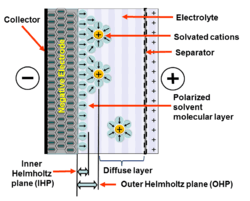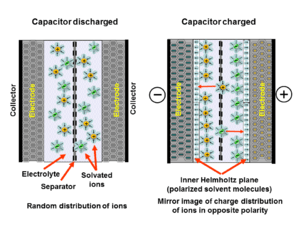Double-layer capacitance
Double-layer capacitance is the storing of electrical energy by means of the electrical double layer effect.[1][2] This electrical phenomenon appears at the interface between a conductive electrode and an adjacent liquid electrolyte as observed, for example, in a supercapacitor. At this boundary two layers of ions with opposing polarity form if a voltage is applied. The two layers of ions are separated by a single layer of solvent molecules that adheres to the surface of the electrode and acts like a dielectric in a conventional capacitor.
The amount of electric charge stored in double-layer capacitance is linearly proportional to the applied voltage and depends primarily on the electrode surface. The unit of capacitance is the farad.
History
- Development of the double layer and pseudocapacitance model see Double layer (interfacial)
- Development of the electrochemical components see Supercapacitors
Capacitance

Helmholtz laid the theoretical foundations of the double layer phenomenon. It is used in every electrochemical capacitor to store electrical energy.
Every capacitor has two electrodes, mechanically separated by a separator. They are electrically connected via the electrolyte, a mixture of positive and negative ions dissolved in a solvent such as water. An area originates at the electrode surfaces where the liquid electrolyte contacts the electrode's conductive metallic surface. This interface forms a common boundary between two phases of matter, such as an insoluble solid electrode surface and an adjacent liquid electrolyte. In this interface occurs a special phenomenon of the double layer effect.[1][2]
By applying a voltage the electrodes generate two layers of polarized ions. One layer is in the surface lattice structure of the electrode. The other layer, with opposite polarity, originates from dissolved and solvated ions distributed in the electrolyte that has moved in the direction of the polarized electrode. These two layers of polarized ions are separated by a monolayer of solvent molecules. The molecular monolayer forms the inner Helmholtz plane (IHP). It adheres by physical adsorption on the electrode surface and separates the oppositely polarized ions from each other, forming a molecular dielectric.
The amount of charge in the electrode is matched by the magnitude of counter-charges in the outer Helmholtz plane (OHP). This is the area close to the IHP in which the polarized electrolyte ions are collected. This separation of two layers of polarized ions through the double-layer phenomena store electrical charges as in a conventional capacitor. The double-layer charge forms a static electric field in the molecular IHP layer of the solvent molecules that corresponds to the strength of the applied voltage.
The "thickness" of a charged layer in the metallic electrode, i.e., the average extension perpendicular to the surface, is about 0.1 nm. It mainly depends on the electron density because the atoms in solid electrodes are stationary. In the electrolyte, the thickness depends on the size of the solvent molecules and of the movement and concentration of ions in the solvent. It ranges from 0.1 to 10 nm as described by the Debye length. The sum of the thicknesses is the total thickness of a double layer.
The IHP's small thickness creates a strong electric field E over the separating solvent molecules. At a potential difference of, for example, U = 2 V and a molecular thickness of d = 0.4 nm, the electric field strength is
To compare this figure with values from other capacitor types requires an estimation for electrolytic capacitors, the capacitors with the thinnest dielectric among conventional capacitors. The voltage proof of aluminum oxide, the dielectric layer of aluminum electrolytic capacitors, is approximately 1.4 nm/V. For a 6.3 V capacitor therefore the layer is 8.8 nm. The electric field is 6.3 V/8.8 nm = 716 kV/mm, around 7 times lower than in the double-layer. The field strength of some 5000 kV/mm is unrealizable in conventional capacitors. No conventional dielectric material could prevent charge carrier breakthrough. In a double-layer capacitor the chemical stability of the solvent's molecular bonds prevents breakthrough.[3]
The forces that cause the adhesion of solvent molecules in the IHP are physical forces rather than chemical bonds. Chemical bonds exist within the adsorbed molecules, but they are polarized.
The magnitude of the electric charge that can accumulate in the layers corresponds to the concentration of the adsorbed ions and the electrodes surface. Up to the electrolyte's decomposition voltage, this arrangement behaves like a capacitor in which the stored electrical charge is linearly dependent on the voltage.

The double-layer is like the dielectric layer in a conventional capacitor, but with the thickness of a single molecule. Using the early Helmholtz model to calculate the capacitance the model predicts a constant differential capacitance Cd independent from the charge density, even depending on the dielectric constant ε and the charge layer separation δ.
If the electrolyte solvent is water then the influence of the high field strength creates a permittivity ε of 6 (instead of 80 without an applied electric field) and the layer separation δ ca. 0.3 nm, the Helmholtz model predicts a differential capacitance value of about 18 µF/cm2.[4] This value can be used to calculate capacitance values using the standard formula for conventional plate capacitors if only the surface of the electrodes is known. This capacitance can be calculated with:
- .
The capacitance C is greatest in components made from materials with a high permittivity ε, large electrode plate surface areas A and a small distance d between plates. Because activated carbon electrodes have a very high surface area and an extremely thin double-layer distance which is on the order of a few ångströms (0.3-0.8 nm), it is understandable why supercapacitors have the highest capacitance values among the capacitors (in the range of 10 to 40 µF/cm2).[5][6]
In real produced supercapacitors with a high amount of double-layer capacitance the capacitance value depends first on electrode surface and DL distance. Parameters such as electrode material and structure, electrolyte mixture, and amount of pseudocapacitance also contribute to capacitance value.[1]
Because an electrochemical capacitor is composed out of two electrodes, electric charge in the Helmholtz layer at one electrode is mirrored (with opposite polarity) in the second Helmholtz layer at the second electrode. Therefore, the total capacitance value of a double-layer capacitor is the result of two capacitors connected in series. If both electrodes have approximately the same capacitance value, as in symmetrical supercapacitors, the total value is roughly half that of one electrode.
Literature
- Héctor D. Abruña; Yasuyuki Kiya; Jay C. Henderson (2008), "Batteries and electrochemical capacitors", Physics Today (12): pp. 43–47, https://ecee.colorado.edu/~ecen4555/SourceMaterial/ElectricalEnerStor1208.pdf
- Béguin, Francois; Frackowiak, Elzbieta (18 November 2009). "8 Electrical Double-Layer Capacitors and Pseudocapacitors,". Carbons for Electrochemical Energy Storage and Conversion Systems. Taylor & Francis. pp. 329–375. doi:10.1201/9781420055405-c8. ISBN 978-1-4200-5307-4.
- Müller, Klaus (1963). On the Structure of Charged Interfaces. Proceedings of the Royal Society. 274. Graduate School of Arts and Sciences, University of Pennsylvania. pp. 55–79. doi:10.1098/rspa.1963.0114.
- B. E. Conway (1999) (in German), Electrochemical Supercapacitors: Scientific Fundamentals and Technological Applications, Berlin: Springer, https://books.google.com/books?id=8yvzlr9TqI0C&pg=PA1
- Leitner, K. W.; Winter, M.; Besenhard, J. O. (2003-12-01). "Composite supercapacitor electrodes". Journal of Solid State Electrochemistry. Springer-Verlag. 8 (1): 15–16. doi:10.1007/s10008-003-0412-x. ISSN 1433-0768. Retrieved 2013-05-24.
- Yu., M.; Volfkovich, T. M. (September 2002). "Electrochemical Capacitors". Russian Journal of Electrochemistry. Kluwer Academic Publishers-Plenum Publishers. 38 (9): 935–959. doi:10.1023/A:1020220425954. ISSN 1608-3342.
- (in German) Electrochemical Technologies for Energy Storage and Conversion, Band 1, Weinheim
References
- 1 2 3 Z. Stojek, The Electrical Double Layer and Its Structure
- 1 2 "The electrical double layer". 2011. Retrieved 2014-01-20.
- ↑ Daniel Gräser, Christoph Schmid: Supercap, Grundlagen - Eigenschaften – Anwendungen. Berner Fachhochschule, Semesterarbeit in Technologie und Deutsch (PDF).
- ↑ S. Srinivasan, Fuel Cells, From Fundamentals to Applications, Springer eBooks, 2006, ISBN 978-0-387-35402-6, Download CHAPTER 2, ELECTRODE/ELECTROLYTE INTERFACES: STRUCTURE AND KINETICS OF CHARGE TRANSFER (pdf, 769 kB)
- ↑ Marin S. Halper, James C. Ellenbogen (March 2006). Supercapacitors: A Brief Overview (PDF) (Technical report). MITRE Nanosystems Group. Retrieved 2014-01-20.
- ↑ Adam Marcus Namisnyk. A SURVEY OF ELECTROCHEMICAL SUPERCAPACITOR TECHNOLOGY (PDF) (Technical report). Retrieved 2014-01-20.